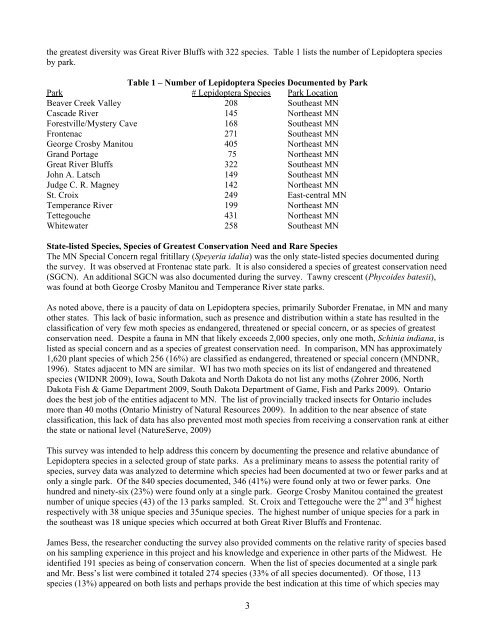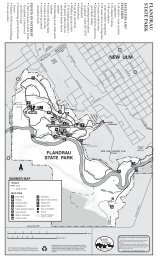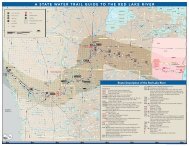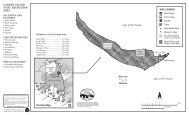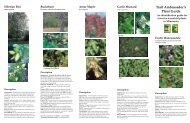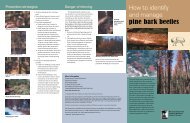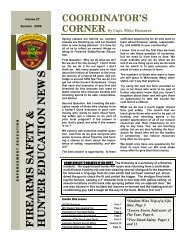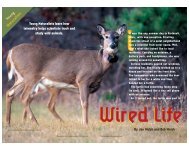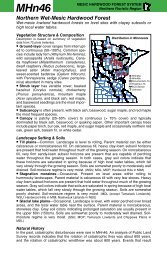A survey of Lepidoptera in three priority areas of the Minnesota state ...
A survey of Lepidoptera in three priority areas of the Minnesota state ...
A survey of Lepidoptera in three priority areas of the Minnesota state ...
Create successful ePaper yourself
Turn your PDF publications into a flip-book with our unique Google optimized e-Paper software.
<strong>the</strong> greatest diversity was Great River Bluffs with 322 species. Table 1 lists <strong>the</strong> number <strong>of</strong> <strong>Lepidoptera</strong> species<br />
by park.<br />
Table 1 – Number <strong>of</strong> <strong>Lepidoptera</strong> Species Documented by Park<br />
Park # <strong>Lepidoptera</strong> Species Park Location<br />
Beaver Creek Valley 208 Sou<strong>the</strong>ast MN<br />
Cascade River 145 Nor<strong>the</strong>ast MN<br />
Forestville/Mystery Cave 168 Sou<strong>the</strong>ast MN<br />
Frontenac 271 Sou<strong>the</strong>ast MN<br />
George Crosby Manitou 405 Nor<strong>the</strong>ast MN<br />
Grand Portage 75 Nor<strong>the</strong>ast MN<br />
Great River Bluffs 322 Sou<strong>the</strong>ast MN<br />
John A. Latsch 149 Sou<strong>the</strong>ast MN<br />
Judge C. R. Magney 142 Nor<strong>the</strong>ast MN<br />
St. Croix 249 East-central MN<br />
Temperance River 199 Nor<strong>the</strong>ast MN<br />
Tettegouche 431 Nor<strong>the</strong>ast MN<br />
Whitewater 258 Sou<strong>the</strong>ast MN<br />
State-listed Species, Species <strong>of</strong> Greatest Conservation Need and Rare Species<br />
The MN Special Concern regal fritillary (Speyeria idalia) was <strong>the</strong> only <strong>state</strong>-listed species documented dur<strong>in</strong>g<br />
<strong>the</strong> <strong>survey</strong>. It was observed at Frontenac <strong>state</strong> park. It is also considered a species <strong>of</strong> greatest conservation need<br />
(SGCN). An additional SGCN was also documented dur<strong>in</strong>g <strong>the</strong> <strong>survey</strong>. Tawny crescent (Phycoides batesii),<br />
was found at both George Crosby Manitou and Temperance River <strong>state</strong> parks.<br />
As noted above, <strong>the</strong>re is a paucity <strong>of</strong> data on <strong>Lepidoptera</strong> species, primarily Suborder Frenatae, <strong>in</strong> MN and many<br />
o<strong>the</strong>r <strong>state</strong>s. This lack <strong>of</strong> basic <strong>in</strong>formation, such as presence and distribution with<strong>in</strong> a <strong>state</strong> has resulted <strong>in</strong> <strong>the</strong><br />
classification <strong>of</strong> very few moth species as endangered, threatened or special concern, or as species <strong>of</strong> greatest<br />
conservation need. Despite a fauna <strong>in</strong> MN that likely exceeds 2,000 species, only one moth, Sch<strong>in</strong>ia <strong>in</strong>diana, is<br />
listed as special concern and as a species <strong>of</strong> greatest conservation need. In comparison, MN has approximately<br />
1,620 plant species <strong>of</strong> which 256 (16%) are classified as endangered, threatened or special concern (MNDNR,<br />
1996). States adjacent to MN are similar. WI has two moth species on its list <strong>of</strong> endangered and threatened<br />
species (WIDNR 2009), Iowa, South Dakota and North Dakota do not list any moths (Zohrer 2006, North<br />
Dakota Fish & Game Department 2009, South Dakota Department <strong>of</strong> Game, Fish and Parks 2009). Ontario<br />
does <strong>the</strong> best job <strong>of</strong> <strong>the</strong> entities adjacent to MN. The list <strong>of</strong> prov<strong>in</strong>cially tracked <strong>in</strong>sects for Ontario <strong>in</strong>cludes<br />
more than 40 moths (Ontario M<strong>in</strong>istry <strong>of</strong> Natural Resources 2009). In addition to <strong>the</strong> near absence <strong>of</strong> <strong>state</strong><br />
classification, this lack <strong>of</strong> data has also prevented most moth species from receiv<strong>in</strong>g a conservation rank at ei<strong>the</strong>r<br />
<strong>the</strong> <strong>state</strong> or national level (NatureServe, 2009)<br />
This <strong>survey</strong> was <strong>in</strong>tended to help address this concern by document<strong>in</strong>g <strong>the</strong> presence and relative abundance <strong>of</strong><br />
<strong>Lepidoptera</strong> species <strong>in</strong> a selected group <strong>of</strong> <strong>state</strong> parks. As a prelim<strong>in</strong>ary means to assess <strong>the</strong> potential rarity <strong>of</strong><br />
species, <strong>survey</strong> data was analyzed to determ<strong>in</strong>e which species had been documented at two or fewer parks and at<br />
only a s<strong>in</strong>gle park. Of <strong>the</strong> 840 species documented, 346 (41%) were found only at two or fewer parks. One<br />
hundred and n<strong>in</strong>ety-six (23%) were found only at a s<strong>in</strong>gle park. George Crosby Manitou conta<strong>in</strong>ed <strong>the</strong> greatest<br />
number <strong>of</strong> unique species (43) <strong>of</strong> <strong>the</strong> 13 parks sampled. St. Croix and Tettegouche were <strong>the</strong> 2 nd and 3 rd highest<br />
respectively with 38 unique species and 35unique species. The highest number <strong>of</strong> unique species for a park <strong>in</strong><br />
<strong>the</strong> sou<strong>the</strong>ast was 18 unique species which occurred at both Great River Bluffs and Frontenac.<br />
James Bess, <strong>the</strong> researcher conduct<strong>in</strong>g <strong>the</strong> <strong>survey</strong> also provided comments on <strong>the</strong> relative rarity <strong>of</strong> species based<br />
on his sampl<strong>in</strong>g experience <strong>in</strong> this project and his knowledge and experience <strong>in</strong> o<strong>the</strong>r parts <strong>of</strong> <strong>the</strong> Midwest. He<br />
identified 191 species as be<strong>in</strong>g <strong>of</strong> conservation concern. When <strong>the</strong> list <strong>of</strong> species documented at a s<strong>in</strong>gle park<br />
and Mr. Bess’s list were comb<strong>in</strong>ed it totaled 274 species (33% <strong>of</strong> all species documented). Of those, 113<br />
species (13%) appeared on both lists and perhaps provide <strong>the</strong> best <strong>in</strong>dication at this time <strong>of</strong> which species may<br />
3


